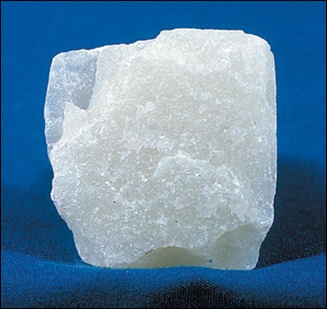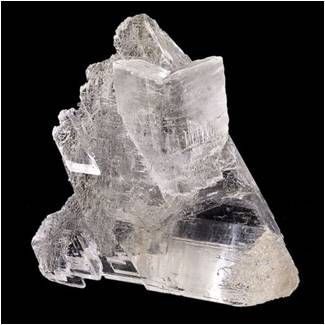Streak: Important diagnostic physical property of coloured minerals
Streak is a thin mark of finely powdered colour
By scratching or rubbing a mineral over a rough unglazed plate – Streak Plate
Example: Chromite and magnetite resemble closely in their other physical properties but they produce:
Chromite – brown streak; Magnetite – black streak
Cleavage: Defined as:
Tendency of a crystallised mineral to break along definite directions .
In other words, cleavage = planes of easiest fractures
These are directions or planes of least cohesion in the atomic arrangement of that mineral
Cubic cleavage, rhombohedral cleavage, octahedral cleavage, prismatic cleavage, etc
Example: Calcite (a crystalline mineral of natural calcium carbonate), Mica (a group of Al Sil. minerals)
)
parting: Defined as:
Property of a mineral to split along some secondary planes
It happens due to the presence of secondary twin planes and gliding planes
Due to presence of substance having different composition or certain stresses
Example: Corundum
Fracture: Defined as:
Appearance of broken surfaces other than cleavage
Common types of Fractures:
Even Fracture: When the broken surface is smooth and flat e.g. chert (a variety of silica minerals that contains microcrystalline quartz)
Uneven Fracture: Defined as:
Breakage of a mineral with irregular surfaces
Example: Fluorite (a transparent to translucent mineral of Ca F)
Conchoidal Fracture: Defined as:
When the mineral has the broken surfaces in form of concentric rings or concavities e.g. quartz
Splintery Fracture: Defined as:
When the mineral breaks with a rough woody fracture / as wood breaks when bent at right angle e.g. kyanite (a bluish-green mineral of Al Sil.)
Hackly Fracture: Define as:
When the mineral breaks with the highly irregular numerous sharp pinching projections e.g. native copper
Earthy Fracture: Defined as:
When the mineral breaks with smooth, soft
and porous surface e.g. chalk
Sectile mineral e.g. Chlorargyrite .
Tenacity: Defined as:
Behaviour of a mineral towards the force which tends to break, bend, cut or crush it. Nature of the minerals with respect to Tenacity:
Sectile: When a mineral can be cut with a knife, like a cheese e.g. Chlorargyrite (AgCl)
Ductile: When a mineral can be stretched into a wire e.g. gold and copper
Malleable: When a slice (cut out) of a mineral can be flattened with a hammer or pressed by the rollers Brittle: When a mineral breaks with a sharp cracking / snapping sound and gives the fine grains or powder when scratched with a knife or pounded with a hammer
Flexible: When a mineral can be bent. Some minerals are not only flexible but elastic too (they regain their shape..)
Elastic: When a mineral is bent, it regains its shape after the applied force is removed
Plastic: When a mineral can be reshaped, moulded or deformed like a semi-solid soil or mud
(viii) Structure / Form: Minerals have characteristic body shape known as physical shapes:
Tabular: When a mineral occurs in flattened, square, rectangular or rhombohedral form e.g. calcite, orthoclase (a mineral of K, Al and SiO), etc
Tabular: -------------------------------- e.g. Calcite

Cubic: When a mineral appears like as it is
formed of cubic crystals --------------- e.g. Halite
Octahedral: When a mineral appears like an
octahedral crystal ------------------ e.g. Diamond
Acicular: When a mineral appears like the
pointed needles e.g. Natrolite (a mineral of
Na, Al Sil)
Elongated: When a mineral appears like
the elongated crystals ------------ e.g. Calcite

Columnar: When a mineral appears like the
column-like crystals --------------- e.g. Quartz

Fibrous: When a mineral appears like as it is composed of fibres e.g. Asbestos
Capillary: When a mineral appears like fine network of hair e.g. Zeolite (microscopic minerals of Al.Sil)
Filiform: When a mineral appears like threads e.g. Zeolite

Radiating: When a mineral is made up of needle-like
formation as appear originating from a common
point or centre .g. Wavellite (an Al phosphate
mineral)

Bladed: When a mineral appears as
composed of thin, flat, blade-like parts e.g.
Stibnite (a mineral of antimony sulfide)
Lamellar: When a mineral appears as
composed of leaf-like sheets e.g. Muscovite
(mineral of white mica – a K Al Sil. mineral)
Foliated: Similar to lamellar but in this case
the individual sheets can be easily separated
from each other e.g. Slate – a foliated
metamorphic rock derived from mud-stone)
Granular: When a mineral consists of grain-like crystals e.g. magnetite, bornite, etc
Globular: When a mineral’s surface appears like
the rounded, overlapping bulb-like or globe-like
projections e.g. hematite (an ore of iron)
Equant or Equi-dimensional: When the
crystals are equi-dimensional whether
perfectly or less perfectly e.g. Olivine (Sil. of Mg
and Fe)
Prismatic: Appearing like prism e.g. Tourmaline
Reticulated: Appearing like lattice or network
of small crystals e.g. Cerussite (a Pb carbonate
mineral)
Dendritic: Appearing like tree or branching
structure e.g. Pyrolusite (a mineral of MnO2)
Nodular: A mineral of rough spherical formation
e.g. chalcedony (a mineral of SiO2)
Oolitic: Appearing like small spheres or round
grains e.g. hematite
Amygdaloidal: Appearing like almonds e.g. Red
Zircon (a mineral of zirconium silicate)
Drussy: Appearing like fine fur e.g. malachite
(a greenish mineral of Cu carbonate)

Massive: A shapeless mineral with no distinct
external crystal appearance e.g. red realgar
(a red ruby of arsenic sulfide) 
Specific Gravity:
Density: It is a fundamental property – mass per unit volume
For minerals, density is expressed in g/cc
Non-metallic minerals have low Density = 2.5 to 4.5 g/cc
Metallic minerals have high Density as high as 22.59 g/cc (that is, of osmium)
In mineralogy, Specific Gravity is used more than Density
Specific Gravity (Sp.G or S.G): A ratio of the density of a substance to that of water at 4o C. As it is ratio, so it has no unit
Specific Gravity is also termed as Relative Density
Specific Gravity of a mineral depends upon:
(i) Composition: Non-metallic minerals have low S.G
(ii) Atomic Structure especially Atomic Radius: Atomic radius is inversely proportional to S.G.
Hardness: A fairly constant and diagnostic property of a mineral
Hardness is defined as: Resistance which a mineral offers to an external disfiguring action e.g. scratching, rubbing, abrasion or indentation
A German mineralogist Friedrich Moh devised a scale known as Mohs Scale of Mineral Hardness in 1812.
Mohs Scale of Mineral Hardness is based on: ability of one material’s sample to scratch another one, by gently scratching each other – usually the softer mineral gives its streak on the other’s surface which is too harder or even harder
Harder minerals were discovered first, softer after that – by finding out that the softer mineral had been scratched
Hardness of some common materials according to Mohs Scale:
Material Hardness Unit
Finger-nail 2.5
Coin 3.5
Iron 4
Steel 4.5
Tooth’s Enamel 5
Knife Blade 5.5
Glass 6
Steel Hammer 6.5
File 6.7
Iron Carbide 6.9
Emerald, Hardened Steel & Tungsten 8
Silicone Carbide 9
Tungsten Carbide 9.3
Boron, its Nitride and Met. Di-borides 9.5Crystalline Form: It is the internal atomic arrangement which gives rise to the arrangement of the crystals in a mineral
Crystallized: When a mineral exhibits well-defined crystals as represented by the crystals and crystal faces – it indicates the Perfect Atomic Arrangement in that mineral
Crystalline: When the well-defined crystals and crystal arrangement are absent but the mineral shows a tendency towards crystallisation as appeared by the development of small grains in that mineral
Amorphous: When both the above-mentioned properties in a mineral are absent – when there is neither a crystal face nor any cleavage is seen. It is due to unordered or indefinite atomic arrangement in that mineral.
Isotropic and Anisotropic Substances:
Isotropic Substances: The substances which do not show the phenomenon of birefringence
They have uniform refractive Index in all directions e.g. diamond, garnet, halite, etc
Anisotropic Substances: The substances which show the phenomenon of birefringence – it is due to crystallographic system of a mineral. E.g. Quartz, Calcite, Fluorite, Tourmaline, etc
Optic Axis: It is an imaginary axis in an anisotropic mineral along which there is no birefringence. This term is relevant to the anisotropic substances only, because there is no birefringence in isotropic substances at all.Optical Signs:
In birefringence, the ray which bends more (in angle) is known as Extraordinary Ray (E-Ray), and the other ray is known as Ordinary Ray (O-Ray).
A mineral is said to be Optically Positive if the velocity of the Ordinary Ray is greater than that of Extraordinary Ray. And vice-versa is for Optically Negative
Polarising Microscope: It is also called Petrological Microscope and differs from an ordinary microscope. In Petrological Microscope, there are two prisms provided – known as Nicols (they act as Polarising Filters – they eliminate all the O-Rays by ‘Total Internal Reflection’). First Nicol is called Analyzer (fitted in the tube of microscope, above the Objectives) and second is called Polarizer (fitted between the Stage and Mirror of microscope).



